UNDERSTANDING AND ADHERENCE TO A HIGH BLOOD PRESSURE PROGRAM IN A RISARALDA CITY COLOMBIA.
DOI:
https://doi.org/10.31052/1853.1180.v22.n3.20652Keywords:
Hypertension, Perception, Drug TherapyAbstract
Objective: To establish the perception of hypertension in a population of the municipality of Dosquebradas attending a promotion and prevention program at the local hospital, and the resulting adherence to treatment. Materials and Methods: A mixed study was performed: Quantitative descriptive cross-sectional, and qualitative hermeneutical analysis on 66 people, who were applied the instruments BIP-Q (Brief Illness Perception Questionnaire), the MBG survey (Martin- Bayarre-Grau), and a semi-structured interview. For the analysis of quantitative data, the Stata 9.0 statistical package was used. For qualitative data, coding, categorization and choosing a central category of the interviews were conducted. Results: From a total of 66 people, 74.24% were female, and 63.6% were over 55 years of age. In the MBG survey, 98.8% had good adherence to drug treatment, 84.4% to diet, and
50% to exercise. In the BIP-Q, 60.6% were concerned about their illness, 57.58% said they have little knowledge about their illness, and 62.1% think they may have some kind of complication. In the interview, people rated hypertension pathology as very serious due to its severe consequences when left untreated. Conclusion: The data obtained in the research yielded variability of results; finding the perception that hypertension is an important disease, which leads to good adherence to treatment. However, it is difficult to establish whether there is a direct relationship between good adhesion to treatment and adequate control of blood pressure, as this was not objectively substantiated.
Downloads
References
Cabrera G, Tascón J, Lucumí D. Creencias en salud: historia, constructos y aportes del modelo. revista facultad nacional de salud pública. 2001; 19(1): 91-101.
Granados G, Roales J, Moreno E, Ybarra J. Creencias en síntomas y adherencia al tratamiento farmacológico en pacientes con hipertensión. International journal of clinical and health psychology. 2007; 7(3): 697-707.
Moreno E, Gil J, El Modelo de Creencias de Salud: Revisión Teórica, Consideración Crítica y Propuesta Alternativa: Hacia un Análisis Funcional de las Creencias en Salud. International Journal of Psychology and Psychological Therapy. 2003; 3(1): 91-109.
Buendía, J, A. Actitudes, conocimientos y creencias del paciente hipertenso sobre la medicación antihipertensiva. Biomédica. 2012; 32: 578-584.
Sabate E. World Health Organization. Adherence to Long Term Therapies: Evidence for Action. Geneva: World Health Organization; 2003.
Acosta M, Debs G, Noval R, Dueñas A. Conocimientos, creencias y prácticas en pacientes hipertensos, relacionados con su adherencia terapéutica. Revista cubana de enfermería. 2005; 21 (3).
Martínez J, Villa JA, Jaramillo J, Quintero AM, Calderon V. Validación del cuestionario de adherencia al tratamiento anti hipertensivo Martín Bayarré Grau. Revista Médica de Risaralda. 2011; 17: 101-105.
Libertad M, Bayarre H, Grau J. Validación del cuestionario MBG (Martín-Bayarre-Grau) para evaluar la adherencia terapéutica en hipertensión arterial. Revista cubana de salud pública. 2008: 34.
Varela M. El reto de evaluar la adherencia al tratamiento en la hipertensión arterial. Pensamiento psicológico. 2010; 7(14): 127-140.
Castaño J, Echeverri C, Giraldo J, Maldonado A, Melo J, Meza G. Adherencia al tratamiento de pacientes hipertensos atendidos en Asbasalud ESE, Manizales (Colombia). Rev. Fac. Med. 2012; 60: 179-197.
Libertad M, Bayarre H, Corugedo C, Vento F, La rosa Y, Orbay M. Adherencia al tratamiento en hipertensos atendidos en áreas de salud de tres provincias cubanas. Rev Cubana Salud Pública. 2015; 41-43.
Granados G, Gil J. Creencias relacionadas con la hipertensión y adherencia a los diferentes componentes del tratamiento. International Journal of Psychology and Psychological Therapy. 2007; 7(3); 393-403.
Terazón O, Ragolta K, Laborí R. Modificación de algunos factores de riesgo en los pacientes con hipertensión arterial en la comunidad. [artículo en línea]. MEDISAN 2009;13 <http://bvs.sld.cu/revistas/san/vol13_6_09/san06609.htm>consulta: 09/05/2015.
Estrada, D, Jimenez L, Navarro E, de la Sierra A. Nivel de conocimientos de los pacientes hipertensos ingresados en un servicio de medicina interna sobre la hipertensión y el riesgo cardiovascular. Rev Hipertensión. 2005; 22: 45-95.
Oliveria S, Chen R, McCarthy B, Davis C, Pharm D, Hill M. Hypertension Knowledge, Awareness, and Attitudes in a Hypertensive Population. J Gen Intern Med. 2005; 20: 219–225.
Ferrera N, Moine D, Yañez D. Hipertensión arterial: implementación de un programa de intervención de control y adherencia al tratamiento en un Centro de Atención Primaria de la Salud de la ciudad de Paraná. Rev Fed Arg Cardiol. 2010; 39(3): 194-203.
Buendia J. Actitudes, conocimientos y creencias del paciente hipertenso sobre la medicación antihipertensiva. Rev Biomédica. 2012; 32: 578-84.
Xiao J, Yao S, Zhu X, Abela J, Chen X. A prospective Study of cognitive emotion regulation strategies and depressive symptoms in patients with essential hypertension. Rev Clinical and experimental hypertension 2011; 33: 63-68.
Flores I, Leon M, Vera E, Hernandez M. Intervenciones psicológicas para el manejo y reducción de estrés en pacientes hipertensos: una revisión sobre su efectividad. Psychologia: avances de la disciplina. 2003; 7(2): 25-44.
Gaviria A, Vinaccia S, Quiceno J, Taborda M, Ruiz N, Francis L. Emociones negativas en pacientes con diagnóstico de hipertensión arterial. Rev diversitas 2009; 5: 37-46.
Downloads
Published
Issue
Section
License
Copyright (c) 2018 Escuela de Salud Pública y Ambiente. Facultad de Ciencias Médicas. Universidad Nacional de Córdoba

This work is licensed under a Creative Commons Attribution-NonCommercial 4.0 International License.
Authors who publish with this journal agree to the following terms:
- Authors retain copyright and grant the journal right of first publication with the work simultaneously licensed under a Creative Commons Attribution License which allows the work to be copied, distributed, exhibited and interpreted as long as it is not done for commercial purposes.
- Authors are able to enter into separate, additional contractual arrangements for the non-exclusive distribution of the journal's published version of the work (e.g., post it to an institutional repository or publish it in a book), with an acknowledgement of its initial publication in this journal.
- Authors are permitted and encouraged to post their work online (e.g., in institutional repositories or on their website) after the publication process. (See The Effect of Open Access). (See The Effect of Open Access).







